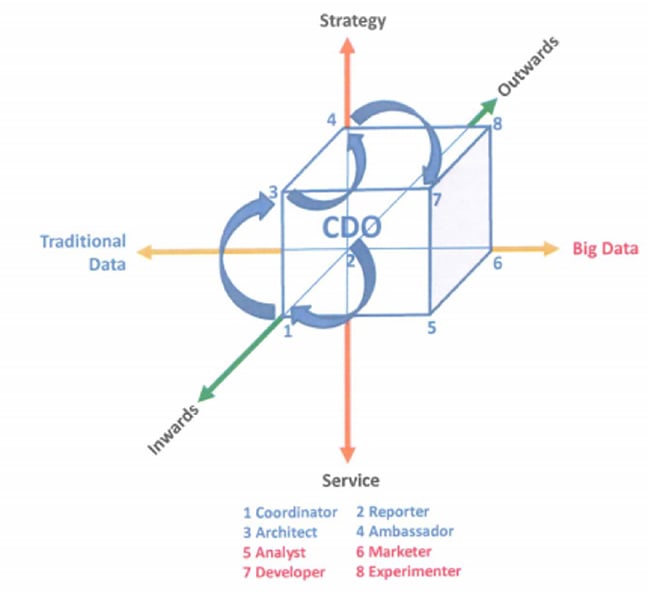In my previous post Unleash the Data Democracy, I discussed that data citizens have had enough of the non-transparency or non-involvement in the very data (reports) they use to do their job. Their frustration has ground-swelled the need for the appointment of a Chief Data Officer (CDO). The CDO is ranked at the executive level and is organizationally sanctioned to establish a data strategy and empower data citizens through a data collaboration platform to change the way business is done. Data citizens, let the real Chief Data Officer (CDO) stand up!
A Shift of Ownership That Impersonates Data Trust
Traditionally, organizations have tackled data problems by assigning a small team within the IT department to ‘clean’ the data. This choice was a historical consequence of the fact that this same IT department also built and managed the underlying data infrastructure since the beginning. Many organizations have managed to escape this tradition and learned that data problems are actually rooted in a business problem. Therefore, data governance should be driven by strong business, strategic, and operational opportunities rather than by data infrastructure limitations.
Over the past decade, a great deal of mechanisms for communication and decision making have been proposed to move the data authority from those who control data infrastructure (e.g., IT) to those who consume data (e.g., ‘the business’). Various data governance competence centers, councils, working groups, and data architecture groups were established to align departmental data managers of the organization. Yet while yielding moderate success rates, the disconnect allowed divergent and incomplete conceptions of data governance to co-exist. Unaligned dynamics of people, process, and data are inefficient and ineffective. It hampers the development of a holistic and systemic enterprise-wide data strategy, leaving many important data issues unresolvable.
The CDO does not replace the existing data managers and their governance mechanisms, but rather enhances their effectiveness by empowering them on a unified collaboration platform. By doing so, their evident success would get amplified and noticed by other executive leaders. This will generate an overall belief that data is a core value rather than a mere by-product. The CDO can build organizational capacity for long-term, data-driven business strategy and innovation. Its office can be held accountable for failure as well as success, and through systematic demonstration of the latter through a data collaboration platform, eventually impersonate trust in data for the entire organization and beyond.
Compelling Events
The shift of data authority and the associated rise of the CDO is often catalyzed by one or more compelling events that impose great risk to or even threaten the very existence of the organization. These events can be of financial, reputational or operational nature. The shift may be also accelerated by strategic R&D investments to seek competitive advantage by exploiting the vast data universe. Moreover, the type of industry of the organization may dictate different starting points (also called use cases) and transition paths between them to sustain the relevance of the collaboration platform in the vision of a changing business landscape.
Three Dimensions to Profile the Chief Data Officer’s Role
Management schools echo this call for the CDO not only by justifying this new role, but also by investigating how different types of the CDO role become invaluable to organizations. In the MIT Sloan report A Cubic Framework for the Chief Data Officer: Succeeding in a World of Big Data, authors Lee, et al. present three key dimensions. We summarize them below and relate them to key data governance use cases that we at Collibra have experienced.
The Collaboration Dimension identifies the focus of the CDO either inside or outside the organization:
Collaborating inwards means prioritizing internal business processes associated with internal departmental stakeholders. Prominent use cases that the CDO focuses on include:
- An enterprise-wide business glossary that collects terms and definitions
- Lineage and traceability paths from terms to (master) data elements and authoritative sources
- A data dictionary providing (technical) metadata for relevant data sources linked up to the business terms
- Data quality rules and dashboards at key hand-off points in the business processes. This requires cross-departmental collaboration.
- Internal report certification and watermarking
- A meaningful and transparent process and responsive ownership for all of the above
Collaborating outwards means the focus is on the extended landscape of external stakeholders such as Suppliers, customers, partners, and regulatory bodies. Important use cases include:
- Regulatory reporting such as BCBS 239, Solvency II, or CCAR
- Data sharing and usage agreements with geo-temporal conditions
- Data marketplaces and shopping carts
- Reference data mapping
The Data Space Dimension captures the focus on the CDO on either traditional (read: transactional) data or the more advanced and diverse big data. Currently, most CDOs are mainly concerned with the basic challenges of traditional data such as getting master data concepts in order. Yet with the advent of self-service analytics and BI, more and more departments take the initiative to crunch data for their own applications which offer more advanced insights than traditional data could offer. The challenge for the CDO is to deal with the enormous data variety and level of autonomy of related data handling that comes with it. Big Data seems to be in the hands of developers, and a lack of data management experience may introduce risks.
The Value Impact Dimension determines whether the CDO will focus on data as a service to fulfill its obligation to improve efficiency of and reduce risk to the business, or whether the CDO looks more at strategies to devise novel data products that give insight for data-driven innovation and competitive advantage. This dimension is about balancing between reducing risk by strictly controlled data usage agreements and leaving enough free flow of data for the self-service data ‘hobbyists’ to realize impactful, but responsible, data-driven innovations.
The Chief Data Officer Rises
The above dimensions provide a tool for the CDO to determine its profile and how he can transcend to another level as the organization changes. Lee et al. (2014) go further by identifying eight roles at the corresponding extremes of the cube based on the three dimensions.

Source: A Cubic Framework for the Chief Data Officer: Succeeding in a World of Big Data
Although we are early in our observations, we can already make some preliminary conclusions based on our own customer landscape.
- Most of the CDOs are currently focusing on traditional data, with both inward and outward collaboration (for regulatory reporting or because of the nature of the business such as data providers or aggregators), and a service focus.
- CDOs who are positioned higher at the enterprise level are better tailored for taking on a more strategy-oriented role.
- CDOs can take on multiple roles at same time, but usually evolve throughout their tenure.
In my next blog post, we’ll dig deeper into the dimensions of CDOs and will give you a way to assess your own traits.




